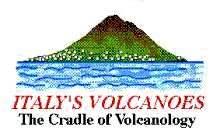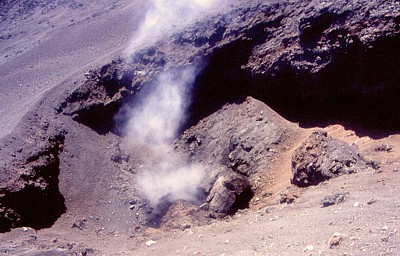|
NOTE: The
restrictions to excursions to Etna's summit area have been
significantly modified.
Free access is now allowed to up to 2500 m elevation (south
flank) and 2600 m (north flank), four-wheel-drive tours
go up to 2900 m on the southern flank (to the place where
there was once the Torre del Filosofo mountain hut, and
close to the newly formed craters) and to about 2500 m on
the northern flank (Piano Provenzana area and entire fissure
of the 2002-2003 eruption). Groups of up to 10 persons may
visit any spot on the mountain if accompanied by an authorized
mountain guide. Read more on the Etna
Excursions page
|
The
latest update is below this line
31
August 2003 update.
No
further eruptive activity has occurred at Mount Etna during the
past three weeks, since its first reasonably serious attempt to
return on the stage on 11 August. Quiet degassing has continued
from the summit craters, among which the Northeast Crater is the
most vigorous.
The fact that the 11 August activity was only an isolated, short-lived
episode may have disillusioned hard-core volcano fans, but to people
living around the volcano and to scientists it means a pleasant
respite, following the frantic period of continuous summit eruptions
(1995-2001) and the two destructive flank eruptions in 2001 and
2002-2003. And despite the current calm, the volcano may - it actually
will - return to vigorous life all too soon.
Two further live-cams have been installed on the upper southern
(Montagnola) and northern
(Pizzi Deneri) flanks of Mount Etna by the staff of Etna
Trekking, an organization of mountain guides based in the town
of Linguaglossa. These webcams complement those of the Catania section
of the Istituto Nazionale
di Geofisica e Vulcanologia (INGV-CT), which look at Etna from
Milo (eastern flank) and Catania (southern base of Etna). This is
a fine initiative coming from a place that is still suffering the
legacy of Etna's latest eruption, which virtually cancelled tourism
business from this side of the volcano. Although jeep tours and
other excursions are once more offered on the northern flank of
Etna, there is hardly any reponse from tourists, tour operators
and travel agencies, and at best a few dozen people per day come
to take advantage of the existing opportunities. This is in stark
contrast with the many thousand daily visitors on Etna's southern
side where reconstruction work is in full swing, and even the cable
car (severely damaged in 2001 and again in 2002-2003) is planned
to be back in function in early 2004.
17
August 2003 update.
The
episode of explosive activity at the Northeast Crater of Mount Etna
on 11 August 2003 seems to have been, for the moment, an isolated
event of fairly small dimensions. A report sent to the Volcano Listserver
by the Catania section of the Istituto Nazionale di Geofisica e
Vulcanologia on 16 August 2003 gives further detail about the episode,
which was accompanied by volcanic tremor and explosion quakes registered
by the seismographs of the INGV monitoring network in the summit
area; however, a visit to the summit on 14 August revealed no continuing
explosive activity, and the seismicity had returned to background
levels. Also on 14 August, Charles
Rivière visited the Northeast Crater and noted a complete
absence of explosive activity, and no products of recent magmatic
activity were found on the crater rims.
Summit activity is often discontinuous and intermittent, and therefore
it is likely that further eruptive activity will occur at Etna's
summit in the near future.
12
August 2003 update.
It
seems like 11 August 2003 is a new date to remember in the history
of Etna's eruptive activity. On the evening of that day, weak, fluctuating
glows were observed at the base of the dense gas column which is
issuing from the crater since many months. The observations were
made from the town of Zafferana, on the southeastern side of the
volcano, and kindly reported by Vittorio Zanon. Field observations
will be made in the next few days to reveal if any fresh magmatic
products have been ejected by the activity.
The Northeast Crater was observed on the previous day by Charles
Rivière, who did not note any evident eruptive activity
but strong degassing. However, Rivière reports audible detonations
from the Northeast Crater on 5 and 6 August, but no visible eruptive
activity is known to have occurred on those occasions. The date
of the ascertained beginning of the new activity thus falls
on 11 August, 195 days after the end of the latest flank eruption.
What does the resumption of summit activity mean?
Firstly, it means that magma has risen to the surface
within the central conduit system of Etna (it is rather correct
to speak of a "conduit system" because there are at least
four conduits, corresponding to the number of summit craters). This
is quite a normal process at what can be said to be the second
most active volcano on Earth, which essentially is continuously
active. Magma is drained from the central conduit system during
lateral flank eruptions, but supply from an assumed upper mantle
magma source is continuous, and thus the system begins to recharge
immediately after the end of a flank eruption. The more magma has
been lost during that eruption, the longer does the recharging process
last. Following the very voluminous 1991-1993 flank eruption, this
process lasted more than 2 years.
During the 2002-2003 eruption, a relatively small amount of magma
(about ten million cubic meters ) was evacuated from the central
conduit system. This was emitted on the northeastern flank of Etna
during the first week of the eruption, and in spite of the great
devastation caused by this lava, its volume amounts only to about
12 per cent of the total volume of the eruption. The remaining 88
per cent of the erupted magma did not come from the central conduit
system, but from a separate (eccentric) reservoir, which is fed
from the same magma source in the upper mantle but does not seem
to be in any direct contact with the central conduit system.
The draining of magma from the central conduit system at the beginning
of the 2002-2003 eruption ended on 5 November 2002, and it can be
assumed that after that date the system immediately began recharging,
even with the eccentric eruption on the southern flank continuing
for another two-and-a-half months. The recharging has thus been
under way for nine months. This is not all too dissimilar to the
recharging period following the 2001 eruption, which lasted ten
months.
Secondly, the new summit activity means that the
newly rising magma has not bypassed the summit craters
and produced a flank eruption, as had been feared by many, and the
volcano is presumably unstable but not as unstable as to give way
immediately to the rising magma and let it drain through its flanks.
Yet there is absolutely no means to say, at this moment, when this
will occur. It can only be hoped that the volcano will give more
warning than the ridiculous two hours of seismicity prior to the
beginning of the latest flank eruption. For the moment, there are
two possibilities how the activity will develop in the next weeks
to months: (a) it may continue at the summit and possibly involve
also one or more of the other three summit craters (the Bocca Nuova
seems the most likely candidate, for it has shown sympathetic activity
with the Northeast Crater also at the end of the previous two repose
periods, in 1995 and 2002). If the summit activity continues long
enough, it might progressively increase and bring a return of beautiful
lava fountains, which is surely the option wished by most people
living and working on Etna; (b) flank instability may facilitate
the draining of magma into the flanks (most likely in those areas
already destabilized during the 2001 and 2002-2003 eruptions) and
thus lead to a new lateral flank eruption in relatively short time.
It does not tell us anything about the state of the eccentric
magma reservoir below the southern flank and its potential of producing
more flank eruptions, whether it is recharging and if it is shifting
- that reservoir does not depend directly on the processes within
the central conduit system. However, the eccentric reservoir seems
to have a strong influence on the stability of the Etnean volcanic
edifice. Spreading and slippage of Etna's eastern flank is now suspected
by many researchers to be largely facilitated by the accumulation
of magma below the base of the volcanic edifice. And it was most
probably a major slip of that flank which in turn facilitated the
eruption of 2002-2003 - both lateral and eccentric.
Thirdly, the renewed summit activity simply means
that Etna is back on the scene. It means that the
period of calm is over, and it reminds everybody that the end of
the 2002-2003 eruption was not the end of all things for Etna, but
that it would give us only a temporary break.
If the July-September 2002 summit activity can be taken as a model
of how the new activity will develop, then it is likely that it
will go on with some fluctuations, sometimes being more vigorous
and at other times absent. It will lead to a gradual filling of
the great central pit of the Northeast Crater. In 2002 that pit
was filled to within 50 m of its rim - see the nice photographic
documentation of that activity by Charles Rivière (July-August
2002, and September-October
2002), the only existing on-line record of that brief eruptive
period. The 2002 Northeast Crater activity lasted from late June
until late September and ceased abruptly immediately after the first
strong earthquake at the Pernicana Fault on 22 September, which
marked the beginning of accelerated flank slip, and probably the
first principal step leading to the flank eruption five weeks later.
If the summit activity extends also to the other craters, these
might undergo a process of filling of their active pits as well.
Presently, the only summit crater that has no inner pit is the Southeast
Crater. If this crater resumes its activity, this may be violent
and destroy the unstable summit of its cone, or gradual, with Strombolian
bursts, and lava outflow possibly from one of its side vents that
were established in 2000-2001.
To see how Etna looks like in these days, visit the new and growing
photo gallery "Return to Etna, 2003".
Many photographs taken during 14 years of visits to, and life near,
Mount Etna are available in the Etna
photo gallery.
A
summary of the 2002-2003 eruption (revised early August 2003)
Piano
Provenzana - a requiem

